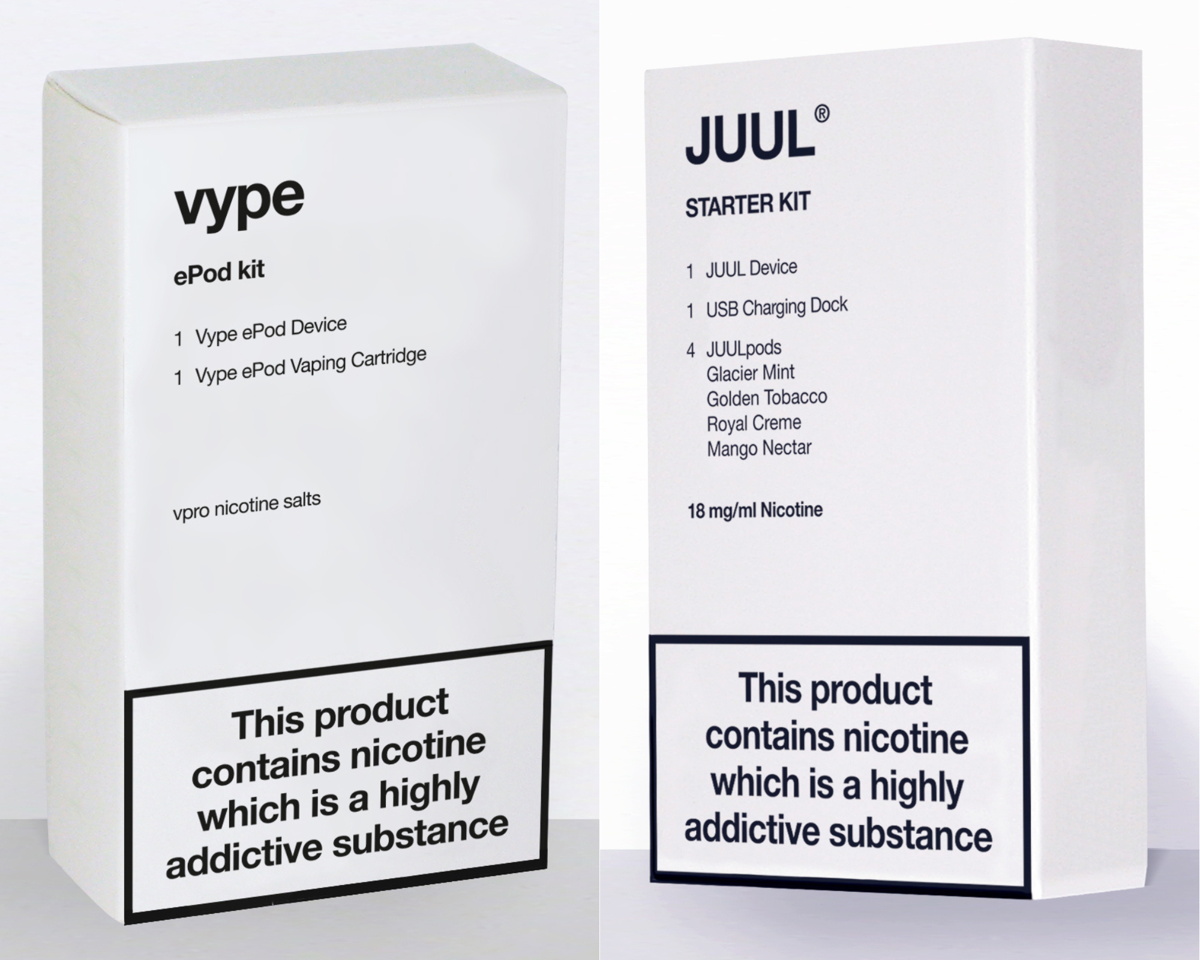Study finds vape plain packaging reduces teenage appeal; ‘Not the answer’, industry feels
March 15, 2023

By Kiran Paul
Standardising vape packaging, by removing brand imagery, is associated with a decrease in vapes appeal among teenagers, a new study has found. But an industry representative said this could have a ‘negative effect’ on smokers switching to vaping.
The research by the Institute of Psychiatry, Psychology & Neuroscience (IoPPN) at King’s College London and the public health charity Action on Smoking and Health (ASH) suggests that regulating packaging could be an effective means of stopping young people from using vapes without lessening the appeal of vaping to adults who smoke.
The research, published in JAMA Network Open, is the first major study into how packaging effects appeal of vaping to teenagers as well as adults.
Respondents, nearly 2,500 teenagers aged 11-18 and over 12,000 adults aged 18 and above, were randomly assigned to view a set of three vape products from one of three packaging conditions – fully branded packs (acting as the control), standardised white packaging with brand name, and standardised green packaging with brand name. They were then asked which of the products would be of most interest to try.
Researchers found that those in the teenage group were more likely to report that their peers would have no interest in vapes when marketed in standardised packaging. This was in contrast to the adult group, whose interest in using vapes was not reduced by the standardisation of packaging.
“Our study found that removing brand imagery from packs reduced appeal of vapes to teenagers without reducing appeal to adults. This is a vital difference, as it means that vapes can still appeal to adults as a tool to stop smoking, particularly because our previous research has established vaping is significantly less harmful than smoking,” commented Dr Katherine East, research associate at the IoPPN and the study’s senior author.
No adverse effect adults
Researchers also found that a greater proportion of teenagers who had never smoked or vaped perceived no interest among people their age in trying any of the products shown in standardised packaging, suggesting that removing brand imagery could deter teenagers from taking up vaping in the first place.
Importantly, standardisation of packaging did not affect interest in trying vapes among adults who smoke, suggesting that policy to reduce branding elements would not deter this group from trying vapes to stop smoking.
“Britain has seen a rise in the number of teenagers using vapes for the first time. While there are a number of steps that policy makers can take, the ideal situation is to ensure teenagers aren’t tempted to take up vaping in the first place, whilst not deterring adults from using vapes to stop smoking. Our study suggests that removing brand imagery could be a means of doing that,” Eve Taylor, research assistant at the IoPPN and the study’s first author, said.
In Britain, 8.3 per cent of adults and 7 per cent of teenagers aged 11-17 reported current vape use in 2022 – a rise of 3.7 per cent in teens since 2021.
Deborah Arnott, ASH chief executive said: “This research shows that it’s possible to make vape packaging less attractive to children, without undermining the appeal of e-cigarettes to adult smokers trying to quit. This is an important finding given the concerning rise in underage vaping in recent times. The government should take note and commit to implementing standardised packaging for vapes and vaping products without delay.”
Device appeal
Commenting on the research, Dr Sarah Jackson, principal research fellow at the UCL Tobacco and Alcohol Research Group, said the ‘neatly designed study’ addresses a key question in the field, but pointed out that plain packaging alone may not be sufficient to bring down the teenage vape use.
“In the UK, plain packaging requirements for cigarettes and hand-rolled tobacco have been in place since 2017 – and data suggest smoking rates have fallen as a result – so there’s precedent for this type of intervention. But while cigarettes look very similar across brands (meaning packaging is the main opportunity for branding), e-cigarette devices come in a wide range of shapes and colours which may still appeal to young people once the packaging is removed,” she noted.
“So while standardising packaging may go some way towards reduce e-cigarettes’ appeal to youth, it’s likely to only be part of the puzzle.”

Responding to the findings of the study, Dan Marchant, director at vape retailer Vape Club, said the vaping industry itself can address these issues.
“I agree wholeheartedly that people under the age of 18 should not have access to vape products, but the problem is not really the products, the problem is the rogue traders who sell them to children,” he said.
He called for a licensing scheme for all retailers of vape products, with the fees from this scheme funding a national test purchasing scheme where every retailer is tested multiple times a year.
“Shops or websites that sell the products to children should be given an immediate fine of £10,000 or above, and the employee involved should also receive a personal fine. There needs to be an actual deterrent rather than a slap on the wrist,” he added.
‘Not the answer’
He claimed that the introduction of nicotine warnings on vaping products in 2017 had a very negative impact, with the number of smokers who believed that vaping was as bad for your health or worse skyrocketing.
“I fear that applying the same level of plain packaging regulations as tobacco products would have just as much of a negative effect and prevent many smokers from making the hugely beneficial switch to vaping,” he commented.
“We do need better vape packaging laws, but plain packaging is not the answer.”
Marchant, who is also a director of the UK Vaping Industry Association (UKVIA), pointed out that the industry body has drawn up a list of suggested packaging guidelines which would have a significant impact without making the products look similar to cigarettes.
“These suggestions include the banning of cartoon characters and childish fonts, ensuring there is no imitation of food products, and not allowing any reference to anything associated with youth culture. These are extremely sensible suggestions which could draw the perfect balance between reducing appeal to children whilst ensuring adults are not misled about the harm reduction benefits of vaping as an alternative to smoking,” he said.
